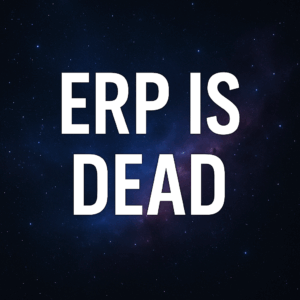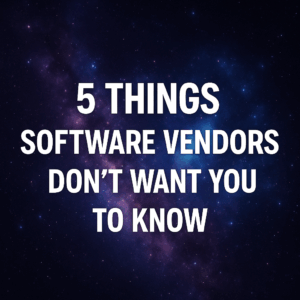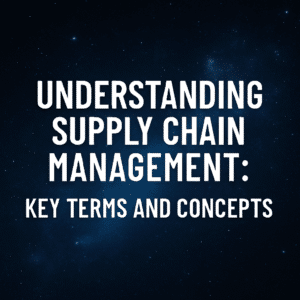When considering potential business technologies for your organization, there’s a lot of options to choose from. The plethora of emerging technologies can be challenging to navigate and difficult to understand what to include in your digital strategy. To help unpack this new frontier, in this blog I offer an overview of the top business technologies to consider within your digital strategy for the 2020s and beyond.
There’s no shortage of options within the business technology landscape. You have ERP systems, CRM systems, human capital management, supply chain management, machine learning, best-of-breed, and single systems that all tie together your entire operations. The key to understanding this menu of new tech is to use your business objectives as a beacon in discovering which emerging technologies to leverage.
Table of Contents
ToggleSupply Chain Management
For many organizations, supply chain management is a critical function. Especially in today’s climate, where supply chains are strained and a variety of limitations within the supply process have been exposed. The importance of supply chain management technology has become the forefront in navigating these challenges.
Now, there’s a host of options out there from big vendors like Infor, Oracle, Microsoft, and other types of providers that provide multiple technologies including supply chain management.
These are very broad ERP enterprise-wide technologies but there’s also a surplus of best-of-breed standalone systems that specialize exclusively in supply chain management. Companies like JDA, Manhattan Associates, and others, are good examples of software vendors that provide technologies that specialize in maintaining and managing supply chains most effectively.
Along with all that, there are also even more micro-targeted technologies you can consider as part of your supply chain management function. Such as,
- Warehouse Management Systems
- Procurement Systems
- Logistics and Shipping
- Freight Management
- Transportation Management
These niche solutions can oftentimes do one specific function much more effectively than broader systems. When defining your digital strategy and roadmap, it’s important to think about, “what are the supply chain-related technologies that I might deploy through my organization?” It is something that should be on your mind when it comes to this emerging technology.

Machine Learning and RPA
Another emerging technology that is great for efficiency and automating human behavior is machine learning and robotic process automation. I’m going to lump these together for simplicity’s sake but technically they’re different technologies. They accomplish the same common goal which is to automate and predict common processes.
Something like invoice processing and whether to pay for the invoice, robotic process automation, and/or machine learning can determine when and where to automatically approve some of those invoices for payment. It can also flag invoices that fall outside of certain thresholds or look irregular compared to past patterns that the technology has picked up on. That’s just one micro example of how machine learning and RPA can be used to automate a simple business process within an organization.
There are also bigger enterprise software vendors, like the ERP providers, CRM, and human capital management providers, and supply chain management providers are starting to incorporate more machine learning and RPA capabilities into their software.
More options in terms of standalone systems are emerging in the marketplace to address capabilities and needs, vs. broader, bigger, enterprise-wide technology. The good news is you have options.
This is an emerging technology that we’re seeing a variety of clients garner efficiency and effectiveness gains. Definitely, something you may want to consider as part of your digital strategy and roadmap.

Business Process Mining
Another tool and type of technology that I’m really excited about, and in fact, our team here at Third Stage uses this often in our consulting engagements, is business process mining tools. There are tools like Celonis that provide the opportunity to mine and understand current business processes.
This is great for not only new transformations or new technology rollouts, but it’s also for organizations that are already using technologies and are trying to get more out of their existing business processes and systems.
What business process mining does, at its simplest level, is it quantifies, and it analyzes different steps in the workflow of your business processes. This helps organization identify and quantify where the breakdowns are happening, how long a process or a sub-process is taking on average, what are the different variations in business, and more actionable insights. BPM provides quantitative data to augment that qualitative tribal knowledge, and it’s also an effective way to prioritize the biggest bottlenecks and problems.
If you’re using a single ERP system and a common set of operating tools and technologies, oftentimes there are hundreds or even thousands of variations in how those business processes are flowing throughout the workflows and systems. Business process mining is an excellent analytical and quantitative tool that can support a digital transformation. It can also encourage organizations that are just trying to get more out of their existing technologies.

Employee Adoption Tools
Another technology worth considering, especially within a digital transformation, is employee adoption tools. These are technologies that are meant to train employees on business processes, systems, and workflows. Many software vendors like SAP and other big ERP vendors have either acquired or developed employee adoption tools that are specific to their software.
There are also more technology-agnostic employee adoption tools out there which, in my opinion, are even more effective. These are tools that can activate employee adoption regardless of what tool they might be using.
If you’re operating in a best-of-breed environment with multiple systems, or employees are engaging numerous systems throughout the typical workday, these employee adoption tools can integrate with all these different systems.
These employee adoption tools are different in that they provide on-demand tutorials as the workforce is using the system and walking through business process workflows. For example, if someone is creating a purchase order and they forgot what fields they need to fill out or what a field name means, they can look to the employee adoption system which is typically embedded within the software that the end-user is engaging.
Similarly, if that same user were to create a PO in one system, and then the next minute, they’re switching to another system to do something else, that same employee adoption tool should be able to support that person’s entire employee journey, or business processes and workflows that they manage day-to-day.
These emerging technologies provide employee support while encouraging workforce communities to leverage business technologies.
Open Source and Low Code Software
Another emerging trend in technology that’s worth considering is open-source technology or low-code technology. They’re technically two different things, but I bring it up as one general category that you might want to consider, and we’ll take each of them one by one.
Open-source software would be vendors or products like Odoo or ERPNext. These are enterprise-wide technologies that are very similar to off-the-shelf systems, but they don’t use proprietary software.
To develop the software, it uses a common programming language you can use to develop or change it to do whatever you need it to do. This can be appealing to a lot of organizations because not only is the software typically sold for a lower cost than some of the more common off-the-shelf systems but it’s written in a shared programming language and doesn’t require specialized skill sets. These are typically technical skillsets found easily on the open market.
Low-code systems are not quite the same as open-source but have some similarities. These are off-the-shelf systems, but they provide low-code tools that allow users to make more significant changes to the software without changing the source code. This provides the flexibility to change workflows, the way screens look, etc.
The main difference between the two though is that low-code technology typically requires less of technical competency, whereas open-source software typically requires more of technical competency. This is not a large distinction if these technical competencies are on staff, but they are not gravitating towards the low-code option might make more sense.
Either way, there are lot of options to consider, and as you’re looking at potential enterprise-wide technologies, you may want to consider those low-code options that give you that flexibility that I mentioned if you have the technical capabilities to support it.


Custom Development and Apps
There are some in this industry that would consider it blasphemy for me to bring up the idea of custom development in applications, but the reality is, that is still a very common option and a viable alternative for a lot of organizations. Creating applications can be very appealing to business operations where it’s warranted but also could create some problems.
One thing that organizations will commonly do is go out and find commercial off-the-shelf systems for as much of their operations as possible. However, oftentimes there are open-ended areas where the off-the-shelf technology doesn’t address all the needs of the business. A way to fill these gaps or these deficiencies with off-the-shelf software is with custom development or applications.
This is especially important regarding competitive differentiators, or a business objective is to create a unique customer experience that can’t be replicated with common off-the-shelf systems. Therefore, sometimes custom development is okay. It’s necessary to force-fit off-the-shelf software into every part of the organization. It may be perfectly viable and suitable from a strategic perspective to leverage these custom applications.
You may already know this, but this isn’t really a new technology, it’s not really emerging, it’s sort of a lost art. It’s a forgotten option that has been drowned out in the enterprise technology space because big software vendors don’t want you to develop your own software. They want you to buy their software, so they’re probably going to tell you that it’s a terrible idea. But as an independent, technology-agnostic provider, we see organizations use these custom applications all the time.
Now, this is not to say that custom-developing basic vanilla technologies from scratch are a best practice because there’s probably off-the-shelf software that can achieve most of the business needs and capabilities better than an expensive, customized option. I’m recommending that you consider all options with a clear perspective, which is not influenced by aggressive vendors.
Other Alternative Technologies
Now, the final category worth considering is sort of a catch-all of everything I haven’t talked about so far, which is anything that’s sort of a best-of-breed, or alternative fringe sort of technology. I don’t mean that in a bad way when I say, “Fringe technology,” I mean that these are technologies that are very niche, very specialized in certain areas.
For example, in Fintech, there are certain technologies that might focus on accounts payable. Within manufacturing, there are manufacturing execution systems. Within sales, there are CRM, customer service, and service order types of solutions.
These niche solutions may not be common household names, but they provide very respectable technologies that might fit in well with your overall digital strategy and roadmap. It’s important to look at these best-of-breed niche industry or functional-specific options, which can vary viable options for a lot of organizations.
Resources
I hope this has given you a sense of what some of those options are as you consider your digital strategy and roadmap for the future. To give you more guidance on additional best practices, technology-agnostic reviews, and thoughts as it relates to your digital transformation, you can check out our 2021 Digital Transformation Report.
This report also includes top 10 rankings of different types of technologies, as well as general best practices for how to make digital transformations successful. As part of your digital strategy and planning, it’s a must-read, I encourage you to download that.
If you have any questions regarding more about emerging business technologies, please don’t hesitate to reach out to me directly. I am happy to be an informal sounding board as you move through your digital transformation journey.






